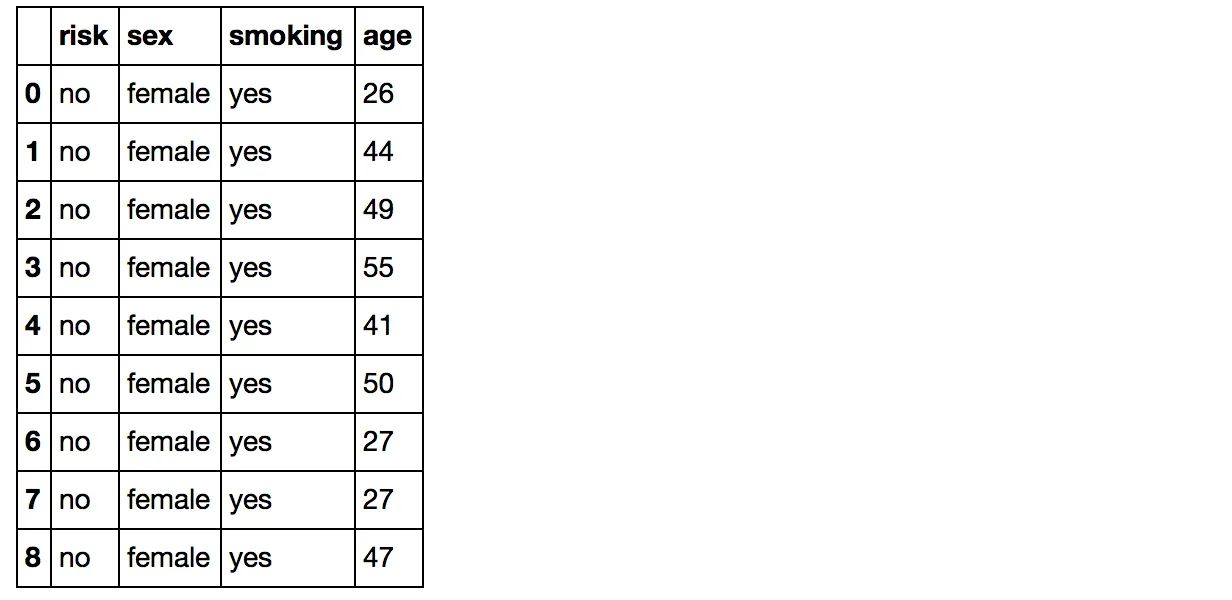您可以使用列表推导式和
concat 和
all 进行操作:
import numpy as np
import pandas as pd
np.random.seed(123)
x = pd.Series(np.random.randint(0,2,10), dtype='category')
x.cat.categories = ['no', 'yes']
y = pd.Series(np.random.randint(0,2,10), dtype='category')
y.cat.categories = ['no', 'yes']
z = pd.Series(np.random.randint(0,2,10), dtype='category')
z.cat.categories = ['male', 'female']
a = pd.Series(np.random.randint(20,60,10), dtype='category')
data = pd.DataFrame({'risk':x, 'smoking':y, 'sex':z, 'age':a})
print (data)
age risk sex smoking
0 24 no male yes
1 23 yes male yes
2 22 no female no
3 40 no female yes
4 59 no female no
5 22 no male yes
6 40 no female no
7 27 yes male yes
8 55 yes male yes
9 48 no male no
tmp = {'risk':'no', 'smoking':'yes', 'sex':'female'}
mask = pd.concat([data[x[0]].eq(x[1]) for x in tmp.items()], axis=1).all(axis=1)
print (mask)
0 False
1 False
2 False
3 True
4 False
5 False
6 False
7 False
8 False
9 False
dtype: bool
df1 = data[mask]
print (df1)
age risk sex smoking
3 40 no female yes
L = [(x[0], x[1]) for x in tmp.items()]
print (L)
[('smoking', 'yes'), ('sex', 'female'), ('risk', 'no')]
L = pd.concat([data[x[0]].eq(x[1]) for x in tmp.items()], axis=1)
print (L)
smoking sex risk
0 True False True
1 True False False
2 False True True
3 True True True
4 False True True
5 True False True
6 False True True
7 True False False
8 True False False
9 False False True
Timings:
len(data)=1M.
N = 1000000
np.random.seed(123)
x = pd.Series(np.random.randint(0,2,N), dtype='category')
x.cat.categories = ['no', 'yes']
y = pd.Series(np.random.randint(0,2,N), dtype='category')
y.cat.categories = ['no', 'yes']
z = pd.Series(np.random.randint(0,2,N), dtype='category')
z.cat.categories = ['male', 'female']
a = pd.Series(np.random.randint(20,60,N), dtype='category')
data = pd.DataFrame({'risk':x, 'smoking':y, 'sex':z, 'age':a})
print (data)
tmp = {'risk':'no', 'smoking':'yes', 'sex':'female'}
In [133]: %timeit (data[pd.concat([data[x[0]].eq(x[1]) for x in tmp.items()], axis=1).all(axis=1)])
10 loops, best of 3: 89.1 ms per loop
In [134]: %timeit (data.query(' and '.join(["{} == '{}'".format(k,v) for k,v in tmp.items()])))
1 loop, best of 3: 237 ms per loop
In [135]: %timeit (pd.merge(pd.DataFrame(tmp, index =[0]), data.reset_index()).set_index('index'))
1 loop, best of 3: 256 ms per loop

merge(DataFrame(tmp, index =[0]), data.reset_index()).set_index('index')可以运行,但不是最理想的方法。 - Psidom